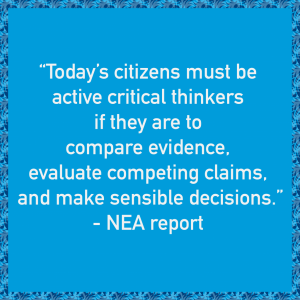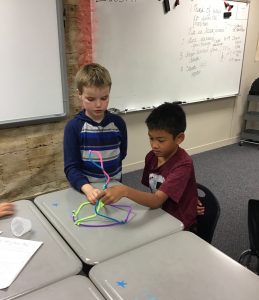The Importance of Using the 6Cs in Elementary Classrooms
To prepare students for a global society that is in constant flux, education experts agree that we must incorporate 21st Century Learning Skills and the 6Cs.
The Three Rs of decades past — reading, writing, and arithmetic — are not enough in education today, say the authors of a 2017 National Education Association (NEA) report “Preparing 21st Century Students for a Global Society.”
According to the report, “If today’s students want to compete in this global society … they must also be proficient communicators, creators, critical thinkers, and collaborators.” Students need these 21st Century skills to flourish as thinkers, problem-solvers, and leaders.
The NEA outlined the initial 4Cs as:
 Critical Thinking: Using reasoning and analysis to respond to and assess situations, experiences, and problems.
Critical Thinking: Using reasoning and analysis to respond to and assess situations, experiences, and problems.
Collaboration: Working together as a team and incorporating the skills and talents of each individual to create a better outcome.
Communication: Presenting information clearly to inform, persuade, or motivate, while also listening to and valuing others’ opinions, voices, and evidence.
Creativity: The ability to innovate and explore new ideas for problem-solving.
Michael Fullan, author, speaker, and educational consultant, added two others to create the 6Cs:
Citizenship: Learning your connection to and role in the global society and culture, and how you can contribute.
Character: Developing responsibility, caring, kindness, and civility.
When educators integrate the 6Cs into their pedagogy and lesson planning, the classroom becomes a safe and collaborative environment. Teaching through the 6Cs taps into the curiosity and innovation naturally found in children.
The 6Cs also improve students’ well-being, giving them the “why” in life, which helps them develop coping skills to combat life’s difficulties.
“Students are being liberated,” Fullan said of schools using this approach. “They care more about school. They care more about life. They care more about making a difference.”
Dusti Street, a science educator who has worked with Studies Weekly, noticed this change in her elementary students after implementing the 6Cs.
“I had a student who hated to come to school. The first day of school, he asked when it was time to go home. After implementing the 6Cs in the classroom, he didn’t want to go home. He loved school and wanted to stay after to learn,” she explained.
Through the 6Cs, another student who struggled with writing became one of the best writers in her classroom. Another, who was shy and would never participate in class, found her voice as she collaborated with classmates, and learned to think critically about situations in the real world.
“I noticed my students wanting to help in the community. They became real-world problem solvers, looking for ways to help others,” Street said of the experience.
Suggestions for integrating the 6Cs into teaching:
1. Introduce the 6Cs one at a time, and make sure students fully understand each C before moving on.
2. Define each 6C. Have a conversation about what the skill looks like and how to use it in the classroom. Often, students create their own definition of what it looks like, Street explained.
3. Practice and model the 6Cs in action. During instruction, highlight when you are using or doing one of the 6Cs.
4. Integrate the 6Cs into lesson plans, and tell students which of the 6Cs were used in their learning.
5. As they become familiar with the 6Cs, challenge them to identify what C was used after a lesson.
6. Give them opportunities to self-assess their abilities in using the 6Cs during projects and activities.
But, how do the 6Cs fit with Social Studies?
Social Studies is the perfect subject to incorporate the 6Cs. Because it touches on the stories, experiences and events of humans throughout the world, social studies naturally challenges students to find their voice and opinions as they reflect and respond to issues, and events.
Students see compelling examples of people using critical thinking and creativity to solve problems and effect change. As they understand others’ stories and experiences, they recognize the essential characteristics needed for leadership, strength, and citizenship. They then learn to collaborate and communicate better with others during discussions and projects.
How do the 6Cs fit with Science?
Science is a fabulous subject to practice the 6Cs. Students naturally question and analyze as they explore phenomena. As they experiment — sometimes with success, and sometimes with setbacks – they learn to persevere. This helps them understand they have the power to solve real-world problems.
They also see the strengths of their teammates, and again, learn to communicate and listen as they work together to make connections, discover patterns, and find solutions together.
For example, Street used a group engineering project that specifically required students to use all 6Cs. She challenged students to create the tallest free-standing tower with 10 pipe cleaners.
 As the students worked, though, Street threw in different situations that added to the task. At one point, she’d tell students their company had to lay off workers, so each student could then only use one hand on the building project.
As the students worked, though, Street threw in different situations that added to the task. At one point, she’d tell students their company had to lay off workers, so each student could then only use one hand on the building project.
A few minutes later, she’d announce that their company was sold overseas, and everyone had to communicate only in that new language (one the students did not know). As a result, the students often had to resort to non-verbal communication.
Finally, she’d announce that the company didn’t order enough supplies. Groups then had to return two pipe cleaners to the teacher.
“With this activity, they learned to collaborate, communicate, and listen in different ways. They also had to be resilient and creative in their problem solving as they adapted to the changes,” Street said.
The 6Cs have the power to change lives and create life-long learners. And the Studies Weekly curriculum team believes that the 6Cs are just as important for student success as literacy and math. Because of this, the 6Cs are incorporated into all of our products.
